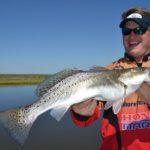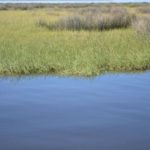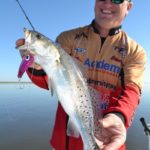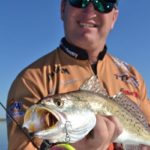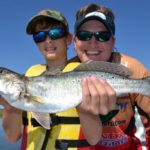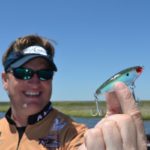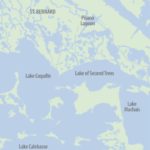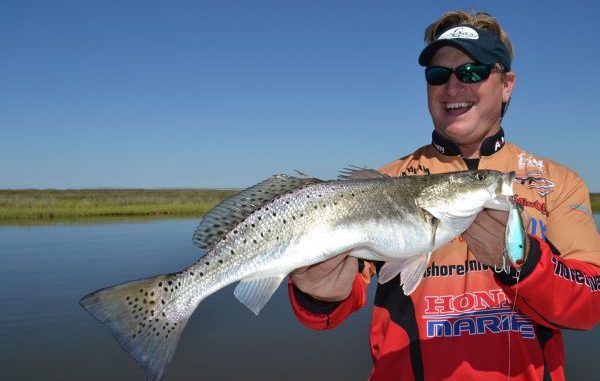
This Hopedale lake comes alive with hefty speckled trout every April.
Hard late-April cold fronts are about as common as honest politicians.
But that was the exact scenario facing Capt. Charlie Thomason last April. He had been on a really strong big-trout bite in Lake of Two Trees during the first half of the month, but then Jack Frost, in a fit of rage during his death throes, blew some of the season’s chilliest weather down to South Louisiana.
Nighttime highs fell into the 40s, and water temperatures plummeted from 80 degrees to 60 degrees.
“We’re going to throw some topwaters today,” Thomason said while bundled to the teeth and motoring away from his Highway 624 dock toward Two Trees. “We’re going to go with the assumption that, since the fish are already programmed to feed like the summertime, they’re going to feed like it’s summertime today.”
The day was dawning like one of those anglers dream about. The air was sharp and crisp, a delightful reprieve from the heat and humidity that always seem to extend tendrils into the earth during the Louisiana spring.
Not only that, but it was completely still. Hopedale’s famous lagoons were like mirrors reflecting the azure sky. God himself, it seemed, had stayed up late the night before to paint such a stunning picture.
But, for the anglers on the boat, there was one fly in the healing salve — and it was immediately apparent to Thomason.
“We’ve got really low water conditions today compared to yesterday,” he muttered as the wake from his Honda 225 pushed cresting waves onto the exposed mud bank along the shoreline.
That’s because “yesterday’s” winds were roaring out of the northwest. As most area regulars know, northwest winds and Hopedale go together like ketchup and ice cream.
But Thomason, an eternal optimist, was far from dismayed.
“We’ve got a really big tide today, and that’s what’s going to help us,” he said. “The water’s going to come up and flood the grass, and that’s where we’re going to catch a lot of our bigger trout.”
That had been the pattern all April, and it’s the same playbook Thomason follows every April, when he customarily catches his biggest fish of the year.
Conventional wisdom when fishing speckled trout is to avoid the shorelines and cast over reefs and shelves on the open-water side of the boat. If you want reds, sure, you’ll fish the shoreline, but speedy trout like the open water where they can slash into schools of hapless baitfish.
But in April, Thomason fishes for specks like he’s an angler gunning for the Redfish Cup.
And these aren’t your average Hopedale school trout. These are some legitimate lunkers. Not 7- and 8-pounders — although Thomason has raked in some that big over the years — but an impressive number of 4- and 5-pounders.
“That’s what I like about fishing big hard-plastics,” he said. “They just seem to weed out the little fish.”
The veteran guide started the day in a Lake of Two Trees cove that he and his team of guides had nicknamed Shell Cove. It was a thing of beauty that screamed speckled trout. It was relatively well protected, had a nice 2- to 4-foot drop-off coming off the shoreline, and was absolutely carpeted with oysters.
“The trout have been getting right up on these banks, because we have a lot of oysters on these banks,” he said. “Right here behind us, you can see this current line.”
Thomason pointed to a distinct slick that was wrapping around the point and pushing into the cove.
“That water gets pushed into this cove,” he said. “All the fish can just sit in here; they feel protected, but then the bait gets washed up through here, and they’re feeding on them real heavily.
“What we’ve been doing is we’ve been fishing that incoming tide that we always get this time of year during the day.”
There was only one problem: The water was cold and low.
Thomason and his anglers threw topwater baits until their arms ached, but the only blowup was from a massive black drum that came out of the water to crash its underslung mouth on top of a He Dog. The fish missed the bait, and moved on to find easier prey.
“We’re not going to catch anything until the water comes up and floods that grass,” Thomason said while pointing to the shoreline.
For the next two hours, Thomason fished other coves and shorelines, more to kill time than anything, until he had determined that the tide had risen enough.
“Alright, let’s go back to the Shell Cove,” he said. There wasn’t a single fish cooling in the ample ice chest.
The return trip took maybe two minutes, and on arrival, Thomason could tell instantly that conditions were better. The water was indeed in the grass, and it was even prettier than earlier in the morning.
At a previous stop, Thomason had switched over to the most-absurd-looking Corky ever invented. It had purply-pink sides with a flaming-chartreuse belly. It looked like body jewelry you’d find dangling from the ear of a Bourbon Street transvestite.
Thomason had theorized that the much-colder water had quelled the topwater bite, and the fish would be much more amenable to hitting something subsurface.
On his second cast in the cove with the audacious plug, he set the hook and battled a solid 2 ½-pound trout to the boat. This wasn’t a 2 ½-pounder your buddy claims to catch a box of in Barataria Bay. This was a legitimate 19-inch 2 ½-pounder.
In the next two hours, Thomason followed that fish with two dozen others of similar size or bigger, including a 24-inch 4 ½-pounder built like a bowling ball and a 23-inch 3-pounder that was more lanky.
And the best thing was, Thomason’s Shell Cove isn’t some magic, secret honey hole. For the rest of the trip, every Two Trees cove that Thomason stopped in held fish. They all, not coincidentally, also had oysters and flooded shorelines.
It’s a truer pattern than anything Kevin VanDam has ever found on the B.A.S.S. tour, and it’s happening right now — even after fierce winds from cold fronts.
That’s because Hopedale cleans up so quickly after a big blow.
“We have a lot of sand in this area,” he said. “It’s not muddy like closer to the river. With that being the case, the sand drops really quick and lets the water clean up.
“But the No. 1 reason is because of the oysters. All this area is all oyster beds. I mean everything. So all these oysters out here, they’re filtering the water. We need maybe 12 to 24 hours; it could be filthy dirty, and it’ll be clean. Tomorrow morning, it’ll be crystal-clear out here. It’s halfway there right now.
“That’s one of the nice things about this area. If you do get some bad weather, you know the next day you can come out here and at least have the ability to find some clean water.”
Although the topwater pattern failed Thomason because of the colder temperatures, that really is the primary way to fish these log-sized speckled trout. It’s also the most fun.
Thomason is a fan of She Dogs on choppy days and Top Dog Jrs. on dead-slick days.
Color depends entirely upon conditions.
“On dark days, you want dark colors and on light days, you want light colors,” he said.
When trout, for whatever reason, won’t come up and smash topwater plugs, subsurface baits pick up the slack. Thomason likes Corkys, MirrOdines and Catch 5s.
He’ll vary his retrieve according to the conditions, but it always involves twitches — never a steady retrieve.
And the best twitches of all are the ones when he pulls back on the rod and the tip doesn’t budge.
That happens a lot this month. Even after crazy-strong April cold fronts.
